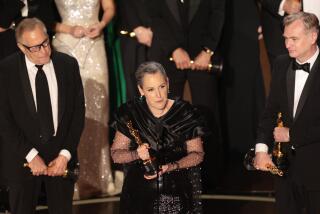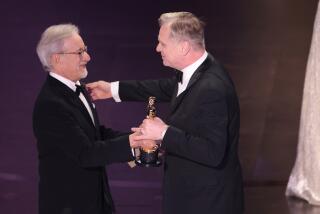Detective work in the Oscar makeup category
Digital effects in the movies have become so pervasive and so sophisticated that audiences can easily accept an actor who ages decades before their eyes or even morphs into a different species.
But digital effects also have made it tougher for Motion Picture Academy members to decide which movies get nominated for the Oscar for best makeup — meaning the old-fashioned kind applied with a brush or attached to a wig or false nose.
“As computer images are getting better and better, it’s very difficult for us to tell” what is makeup and what is a computer effect, says special makeup effects designer Matthew W. Mungle, who used makeup and prosthetics to help make Glenn Close look like a woman who could pass for a man in this year’s “Albert Nobbs.”
Members of the academy’s makeup and hairstyling branch spent part of Saturday at a meeting narrowing the list from seven finalists to the three nominees, who will be announced with the rest of the Oscar nominations Tuesday morning. Part of the work is making sure the makeup and prosthetics were applied by hand and not via computer.
“We ask for photographs of them doing the work — more so than years before — in order to prove that it was hand-done. There’s more discussion about it now. It’s made the meetings at least an hour longer,” says Mungle, an Oscar winner for his work on 1992’s “Dracula” and an active member of the makeup branch.
Even submission packages from Oscar hopefuls are more nuanced now. “I never thought about it in 2000, but now I have to,” says Lea Yardum, an awards campaign consultant for more than a decade. “You have to be more thoughtful in how you prepare the [submission] materials. You just want to be sure if you’re working on a movie that’s CGI that you’re differentiating what’s [computer-generated imagery] and what’s hand-applied. You can’t just leave it up to the committee.”
Leonard Engelman, governor of the makeup branch, denied that the meetings are taking longer and downplayed any complications because of digital evolution, but he doesn’t dispute that it’s increasingly hard to discern what is traditional makeup artistry and what’s been digitally rendered.
“A lot of times it’s difficult, very difficult,” Engelman says. “When I saw ‘The Iron Lady,’ I emailed [prosthetic makeup designer] Mark Coulier and asked ‘Was there CGI work done on it?’ because it’s so flawless. And he emailed back saying there wasn’t.”
This sort of honor system — contacting makeup artists and hairstylists to ask what if any digital work was done on their films — is the main way the nominating committee clarifies questions. Sometimes, however, makeup artists don’t know what was done to their work in postproduction; in which case, Engelman must call visual effects supervisors and others on the film directly to “detective work it a little more,” he says.
Digital cleanup on makeup work is a particular concern, he says, because filmmakers sometimes ask visual effects companies to keep it secret. “We want to be recognizing outstanding makeup,” Engelman says, “not makeup that maybe had bad edges and they went in and got rid of the edges through CGI.”
Engelman says 2011 was a “particularly strong year” for makeup in movies. Among the seven finalists that were voted on Saturday: two re-creations of historical characters (“The Iron Lady” and “Gainsbourg: A Heroic Life”), three period pictures (“Anonymous,” “Hugo” and “The Artist”), one film involving gender transformations (“Albert Nobbs”), as well as “Harry Potter and the Deathly Hallows: Part 2.” Makeup artist contenders gave detailed presentations, showed 10-minute film clips and answered questions at the Saturday session.
“There’s a responsibility to go and present the work and show what we did,” says Coulier, who helped transform Meryl Streep into former British Prime Minister Margaret Thatcher at various ages in “The Iron Lady.” “It’s very difficult these days to know if the makeup has been reworked — and it raises some interesting questions about what can be considered for an award.”
Coulier says none of the makeup in “Iron Lady” was digitally enhanced. “It’s very irritating to me when you’ve done really nice makeup and you take a photograph of it and people think you touched it up in Photoshop. Hopefully people will see it up there on-screen and know.”
Films often mix digital cosmetics with actors in makeup. Michael Owens, visual effects supervisor to “J. Edgar,” Clint Eastwood and Dustin Lance Black’s dramatization of the life of J. Edgar Hoover, says Armie Hammer’s and Naomi Watts’ characters in the film were significantly digitally aged in postproduction. Wrinkles, bags under the eyes and jowls were added. But no such effects were used on Leonardo DiCaprio, who played Hoover.
Aging the actor over decades was hand-done by makeup designer Sian Grigg. When Hoover’s receding hairline, vastly different than DiCaprio’s, presented unique challenges, producer Robert Lorenz suggested aging the actor digitally, Grigg says, but she convinced him otherwise. She felt a handcrafted bald cap, which took nine days to create, would look more natural. “J. Edgar looked a bit of a bulldog, really. He had a really big face,” Grigg says. “I was trying to get the essence of Hoover onto Leo’s face in any way I could.”
Controversy over the makeup Oscar is hardly new. Debate over what is award-worthy dates to the award’s inception in 1982, according to Rick Baker, a seven-time winner in the category. Baker has a particularly broad perspective — not only did he nab last year’s Academy Award in makeup for “The Wolfman,” he also won that first makeup Oscar for “An American Werewolf in London.” .
“Even at that time, before CGI was even used, there was some debate about what really is makeup and what isn’t,” he says. “The stuff I did [then] crossed the line between traditional makeup and practical special effects, like mechanical effects. It was a gray area. When I won for ‘American Werewolf’ … people said, ‘That’s not makeup, that’s on a robotic head. That was a special effect.’”
Most movies today use elements, he says, of both digital and special makeup effects — to varying degrees. “The Curious Case of Benjamin Button” in 2008 completely blended the line, aging the characters with a combination of sculpted prosthetics, makeup, motion capture and CGI.
“Digital is in every film now; it’s hard to draw the line,” says Baker, who calls himself a makeup artist but also creates his designs digitally. “I embrace the technology — any trick in our bag of tricks is a great thing.”
Adds Coulier: “In the future, who knows — we may end up with a separate award for best CGI/makeup.”
More to Read
The biggest entertainment stories
Get our big stories about Hollywood, film, television, music, arts, culture and more right in your inbox as soon as they publish.
You may occasionally receive promotional content from the Los Angeles Times.











